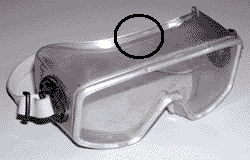Safety Glasses
Science Olympiad has provided definitions of the various kinds of safety glasses that are to be used in SO events. However, the explanations do not provide any pictures of the glasses in question. To clear up any confusion, here is a list of URLs where you can see examples of each type of eye protection.
Class 1 or 2: The glasses in this picture have removable side-shields. When the side-shields are removed, they would classify under the first criteria. With the side-shields on, they might pass the second criteria. However, there are far better designs of class 2 glasses. Removable Side-Shields
Class 2: These are the kinds you are most likely to see in a woodshop, and are preferable to the design I mentioned above. Glasses with Permanent Side-Shields
Class 3: This picture shows goggles that have perforations along the top and sides. Impact goggles
Class 4: These kinds of goggles have impact resistant lenses. The circular, white vents at the "corners" of these goggles are designed to keep liquids.Splash/Impact Goggles
Class 5: Apparently, this class simple refers to any eye-protection that meets the ANSI standard for High Impact resistance. So, the form factor is irrelevant, as either goggles or glasses can meet this specification.
Please note that the pictures may not show glasses that are actually ANSI rated. They were merely chosen for visual similarity to the classes listed at soinc.org.
Unfortunately there is no "master list" of eye protection required for all events. One solution is to provide High Impact Chemical/Splash Protection Goggles which may be worn in place of any of the other types.
To be approved eye protection devices must be marked with "Z87".
This can be hard to see, especially on devices made of clear material. Removable lenses must also bear the "Z87" mark. Regular eyeglasses with safety glass are not approved unless they bear this mark.
There are 4 types of primary eye protection devices:
1. Safety spectacles:
These devices provide protection against flying particles coming from in front of the wearer. They rarely meet requirements for Science Olympiad events.
2. Safety Spectacles with Side Shields:
This type of protection guards against particles from the side as well as the front. Due to multiple teams competing in close proximity at the same time, this is usually the lowest level of protection suitable in Science Olympiad events.
3. Particle Impact Protection Goggles:
This eye protection has a shield that fits tightly to the face on all sides (including top & bottom). These goggles have vents consisting of small holes or screen that may allow a straight line path for liquids to enter the eye (you can see through the holes).
4. Chemical/Splash Protection Goggles:
These devices have covers over the vents, eliminating any straight line path for foreign matter to enter the eyes.
Any type of eye protection may be worn in place of those types listed above it. Chemical/Splash Protection Goggles may be worn instead of any of the other types.
Impact Protection:
An additional characteristic to consider is Impact Protection. Each of the above types of eye protection is available in either Basic Impact or High Impact Protection versions. Devices marked with "Z87" provide Basic Impact Protection. Devices that provide High Impact Protection are marked with a "+" in addition to the "Z87" ("Z87+"). Devices used in events where the rules require High Impact Protection must bear the "Z87+" mark.
Face shields and other types of protection:
Eye protection devices not listed above are secondary devices and, if used, must be worn in conjunction with the primary devices listed above.
Proper eye protection is a requirement:
Contestants must not be allowed to participate without the level of protection required (or higher) by the rules. It is sometimes impossible for event supervisors to know what hazards a team's device may present; therefore, it is incumbent upon teams to bring and wear a higher level of protection than what is specified in the rules when their device warrants it.






